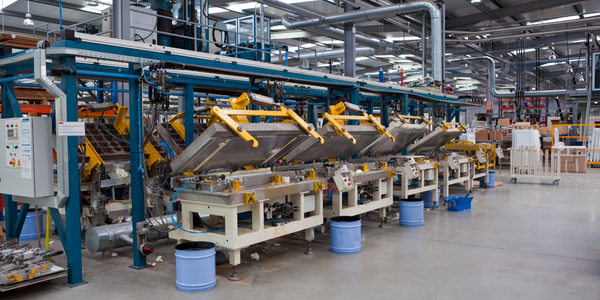用例
- 人员跟踪与监控
- 时间敏感网络
服务
- 系统集成
关于客户
Fitzsimons Temple Bar 是位于都柏林 Temple Bar 区的著名派对场所。该场地共五层楼,提供多种体验,包括多家酒吧、现场音乐、可欣赏 Temple Bar 壮丽景色的屋顶花园以及周末夜总会。 Fitzsimons 餐厅每周开放七个晚上,是参加都柏林派对的人和游客的热门选择。该场馆由总经理 Krisztina Hegedus 管理,负责监督日常运营并确保业务顺利运行。
挑战
Fitzsimons Temple Bar 是都柏林颇受欢迎的夜生活场所,其现有的员工管理软件面临着重大挑战。该系统不方便用户使用,并且由于其笨拙的界面而经常被忽视。这导致许多功能过时,工资单处理等任务变得非常耗时。总经理 Krisztina Hegedus 表示,每周一都要花费 3-4 个小时来处理工资单。此外,系统无法准确记录员工上班和下班时间,导致计算不正确并给企业带来额外成本。缺乏准确性和效率是管理层的主要担忧,他们知道这种情况无法持续下去,而不会对业务产生负面影响。
解决方案
为了寻找更高效的解决方案,Fitzsimons Temple Bar 转向 Bizimply,一款基于云的员工管理软件。 Bizimply 的实施不仅是为了简化薪资处理,也是为了更好地控制成本并对薪资和支出进行日常审查。该软件提供了详细的成本可视性,包括每个部门的成本和预测收入,事实证明,这改变了企业的游戏规则。由于软件将上班和下班时间直接同步到帐户中的考勤卡,因此无需手动输入,员工出勤数据变得完全准确。 Bizimply 的用户友好界面使薪资处理变得简单高效,并且该软件能够创建流行的轮班时间和颜色代码职位,这极大地有助于管理业务的各个部门。
运营影响
数量效益

Case Study missing?
Start adding your own!
Register with your work email and create a new case study profile for your business.
相关案例.

Case Study
Goldcorp: Internet of Things Enables the Mine of the Future
Goldcorp is committed to responsible mining practices and maintaining maximum safety for its workers. At the same time, the firm is constantly exploring ways to improve the efficiency of its operations, extend the life of its assets, and control costs. Goldcorp needed technology that can maximize production efficiency by tracking all mining operations, keep employees safe with remote operations and monitoring of hazardous work areas and control production costs through better asset and site management.

Case Study
Cisco Kinetic for Oil and Gas: Refineries and Plants
The plant manager and safety teams needed a solution that provided near real-time visibility of gas detection and personnel location, with easy to understand visualization and alerting dashboards. This would enable them to improve productivity through decreasing the time taken to start work, optimize evacuation route planning, and to meet critical staff safety and compliance goals.

Case Study
Industry 4.0 at ALPLA: Enhancing Factory Efficiency with IoT
ALPLA, a global leader in packaging solutions, faced several challenges as the complexity of their production machinery increased. The need for highly trained specialists in each factory led to higher personnel costs, difficulties in recruiting experienced talent at each location, and costly personnel turnover. Furthermore, less experienced operators running the machines sub-optimally impacted resource consumption and overall equipment effectiveness (OEE). ALPLA also faced the challenge of monitoring visual inspection systems in every line of their plants, which was almost impossible to do manually. In 2016, ALPLA decided to use data from the 900 different types of embedded sensors in each factory to address these issues. However, their initial choice of SQL Server as the data store for the sensor data proved inadequate, as it was unable to cope with their data requirements.

Case Study
Digital Transformation of Atlanta Grout & Tile: An IoT Case Study
Atlanta Grout & Tile, a Tile, Stone & Grout restoration company based in Woodstock, Georgia, was facing challenges with its traditional business model. Despite steady growth over the years, the company was falling behind the web revolution and missing out on the opportunity to tap into a new consumer base. They were using independent software from different vendors for each of their department information and workforce management. This resulted in a lot of manual work on excel and the need to export/import data between different systems. This not only increased overhead costs but also slowed down their response to clients. The company also had to prepare numerous reports manually and lacked access to customer trends for effective business decision-making.

Case Study
Centralizing Data for Improved Efficiency: A Case Study on Malvern Panalytical
Malvern Panalytical, a UK-based hi-tech electronics company, was grappling with the challenge of decentralized data storage. The company had a vast amount of unstructured data scattered across various platforms, from hard drives to emails and floppy disks. This made the data searching process extremely cumbersome and inefficient. The company's rapid growth, from 200 to over 1,000 employees in a decade, and expansion across three continents further exacerbated the need for a more structured and centralized data system. As a company involved in electronics manufacturing and software development, it was crucial for Malvern Panalytical to find a platform that could structure all their data, track all modifications of documents in real time, and provide clear visibility of the internal information flow across all its facilities.








